|
ORIOLES AND HERO'S WETLAND
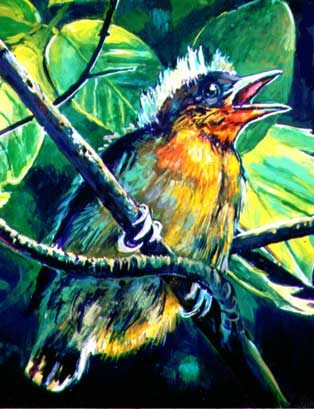
Hero The Oriole
Ode To Orioles
(in two parts)
Part 1
About Hero the Oriole and How He Got his Name.
My wife and I found a small wetland
Of cattails and sycamores
some people called a "swamp"
and wondered why it was not drained.
We were walking on a little peninsula
that jutted out into the waterplants.
A bird was chattering above us, very upset.
I was watching a Red Headed Woodpecker
but the insistent chatter of the Oriole
caught my wifes attention.
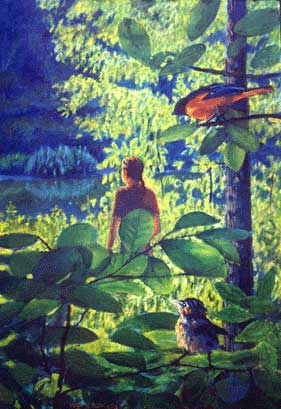
Hero, his Dad, and my Spouse
I looked around, and as I did a baby Oriole leapt from
our path
right into the waterplants, hopping out a log into the pond.
His mother was chattering in protest because we were about
to stumble onto her baby.
She was right and her complaints were just.
The baby hopped off the log and fell into the water.
It was our fault, though we intended no harm.
The baby bird was in danger of drowning.
So I walked out the log, balancing myself with a staff
and perched the baby on small twig
and brought it back to the peninsula
and set it at the base of the birth-tree.
"What a hero he is" I said to my wife
and we backed away thirty feet, behind some bushes
and watched to see if the mother would feed it.
Right away she arrived with food for her wet baby.
She chattered and called to it sweetly,
encouraging it to climb upward.
Then we saw a blurr of tiny wings, and Hero’s brother
or sister
came fluttering down from the nest.
Two babies.
After watching the mother feed them both for awhile, we left----
sure that the little Hero and his sister or brother were safe.
And this is why I named this place Hero’s Wetland,
after a brave baby bird that fell into the water
but climbed up in a tree and survived.
Hero’s Wetland, would prove to be a hidden place full of
many unsung Heroes.
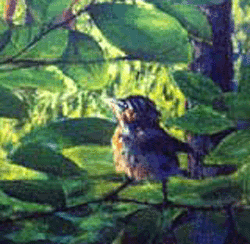
Hero
The next day I returned and found Hero
and his brother or sister and his parents gone.
I was surprised.
It raised the question of what happens to baby Orioles
When they leave the nest.
I wanted to know
and called various ornithologists. No one knew.
So a year passed, and I was ready the next year to find out.
Hero’s parents returned to the same peninsula.
They nested in the tree next to the tree of the previous year.
I waited the few weeks until the babies showed signs
they would come out of the nest.
There were three this time, and each one fluttered down
in a blurr of wings, just like last year. Over succeeding years
I ended up calling this time
the time of the Rain of Orioles---
since all over the wetland, the many Orioles nests give up their babies
and over the course of a few days Orioles rain down from the trees
here and there, in a fluttering of tiny silver wings.
So I learned what happens when they crawl out of the nest.
The parents call them from a distance
and encourage them to come out.
They know when the babies are ready.
After the babies reach the ground
each one found a tree to climb up, crying for food,
encouraged by their parents.
The parents even use the food
as an inducement to climb higher.
A few of the young I watched
did not manage to climb into a tree the first day
despite the constant importuning of their parents.
These worried me as much as they worried their parents.
They were at great risk on the ground.
But all the baby orioles I watched over 3 years
made it into the trees.
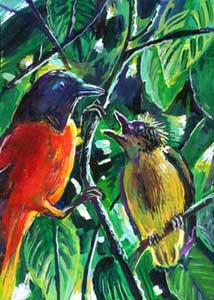 d d
Hero and his Father
For three days, I charted the progress of Hero and his brothers or sisters
into higher and higher branches.
By the second day the birds were flying from twig to adjacent twig
by the third day they were forty feet up in the walnut and sycamore trees
And then into the 80 foot cottonwoods.
The third of fourth day they could fly farther and were all gone.
The same process happened the next year, more of less,
with the Orioles in different trees.
After the third or fourth day their elaborate education begins.
Various bird books say that Orioles tend to nest separately.
But at Hero’s they nest in a colony, with at least 10 pairs---
though this varied over different years.
The birds are probably all related, to some degree.
The bird books also say that in Central and South America
where they over winter, the Orioles tend to travel in groups.
I suspect that these groups are closely related birds
who migrate to the same areas
and return to the same areas the next year.
Orioles can be loosely communal and I suspect
that if I were able to travel with Hero's family to, say, Costa Rica
there is another Hero's Wetland down there,
where the many Orioles of Hero's Wetland stay loosely together.
The fact of this migration and family resilience over
an area of thousands of miles fills me with admiration.
No one knows exactly what the daily life
of an oriole over a years or years is like
and one of the main questions I had watching them for 3 years
was just what they did after they flew
from the high trees surrounding the
nests.
I would occasionally see Orioles in late summer----
young birds with the mother or father, but they are always
on the move, and it is very hard to determine what their lives are like.
Certainly their lives are as complex and interesting
to them as human lives are to humans.
From what I gather from observation, it appears
that the whole summer is spent in wandering
teaching the young birds how to be adults
until migration in the fall.
I have seen one family take care of the
young for more than a month beyond fledging the nest.
Both the male and female attended to the babies,
the babies continuing to ask for food a month after learning to fly
The bird books say that it is the male that cares for them,
but this is not always true.
The family was close in contact, intimate
and stayed within earshot of each other all through July
eating Mulberry berries, bugs,
and sweet water I put out for them.
The three young I watched quickly grew
to be as large as their parents
and looked like their mother.
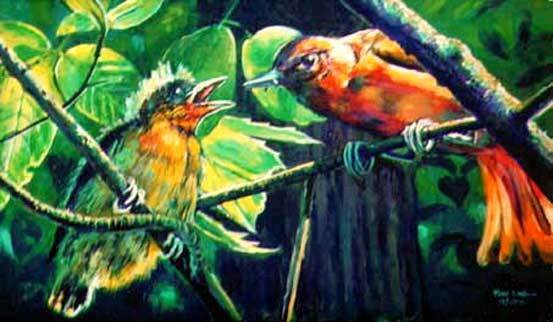
Hero and His Mother
The Northern Oriole is gold in some lights
hence the Latin or Spanish "oro" or gold.
But in other lights it is yellow, orange or even crimson.
This bird has nothing to do with the blood covered gold rocks
that Europeans coveted to the harm of continents.
It is not gold like the rock of that name
but gold as a sunrise, orange and yellow
like the fruits it loves to eat.
I would rather it were called the Sunrise Bird,
since its black back has white streaks across it
like clouds under the moon
and its breast is brilliant yellow orange
as the sun rising to eclipse the night.
But no matter, Oriole will due.
It is not as badly named as the Monarch butterfly
which has nothing to do with the ego of Kings.
The Oriole is a seeker of luminous fruit
and loves to nuzzle and eat flowers
seeking the nectar of Yellow Buckeyes
and other flowering trees.
Its clear and melodious song at sunrise
echoes a dream of spring orange blossoms
more sweetly yellow than ripe pears
replete with the innocent clarity of spring dawn.
Burnished copper is not as bright
nor is crimson fire in stained glass as luminous
It is more of fire than sun shinning through wine
or orange autumn leaves
caught in the wind and
rising into the red sky at sunrise.
.
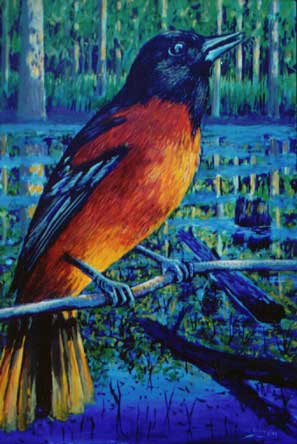
Hero the Oriole Grown Up
and Returned to Hero's Wetland
The female is not as brightly colored,
but just as beautiful, with a hints of orange, ochre and purple
like orange grasses in a wheat colored autumn field.
They both are quick witted and very intelligent
and live their lives at a pace that
made me feel clumsy and slow.
The males return to the Wetland before the females
flying thousands of miles.
They sing loud songs of yearning as they wait
for the females to return from the south.
When the females return, the male and females
stay in close touch with each other all day
calling to one another as the busy about eating and
loving and getting ready to nest.
Once they decide where they will nest
the female begins seeking nest material
as the male watches nearby.
She is incredibly thorough about doing this
and inspects anything that might be used as thread.
Her preference at Hero’s Wetland is milkweed fiber,
a plant which not only is a host to orioles
but also to Monarch Butterflies and Milkweed Beetles,
which, like the Monarch and Oriole, are also orange and black.
This plant, the orile and the beetles harmonize with one another
and appear to have evolved together, and like old friends or couples
come to resemble eachother.
It is spring and last years Milkweed stems are still standing and stiff.
She lands on one and dances up the stem like a tight rope walker
and expertly uses her beak to tear open the stem.
I used to make a living weaving and restoring carpets
and her skill and speed with her beak far surpassed
what I could do.
She pulls out a thread, careful not to break it
and then dances further up the stem
pulling at it like a gymnast, until at last
she has a long thread of a foot or more
and she flies off to her nest with it.
Sometimes the thread catches on a branch as she flies
and loathe to let it go,
she holds on and it jerks her back in mid-flight
like Charlie Chaplin being jerked back by his own cane.
When I saw this happen a few times, it was hard not to laugh.
But she is determined, and untangles the thread and brings it to the nest.
She appears to twist or slightly spin the thread
like silk or wool, to make it stronger
as she darns the thread into and out of the growing nest.
She uses her beak like a needle
weaving a satin bed for her babies.
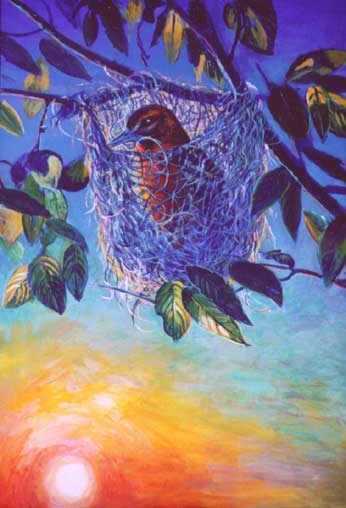
Weaver of Dawn
She works: darning and weaving, going to get more thread
darning and weaving as ths the sun rises
and climbs into the middle of the sky and
then begins to go down.
She stops only occasionally to drink
from the wetland or eat.
For tow or three days she weaves.
The male encourages her and feeds her
as she begins to settle into the finished nest.
I could often hear her respond to his calls with
a delicate voice from inside the nest.
The nest as it grows is like a wedding veil
holding lilac and rosy light, shimmering with the soft
fine-spun fiber as the sun rises.
She weaves her nest of twilight silk
the embroidered beauty of dawn.
Gossamer filaments glisten in the sun
wound around twigs, stitching silver satin
into a shimmering veil,
designed not to keep the world out
or to separate this world from that,
like a forbidding mystagogue,
but rather
and she does it in praise of this world---
the only world there is.
She weaves beautiful threads of the earth itself
into a nest of dreams, to give the earth back to itself
to give new life to life and new being to being.
She does it
for her mate and her babies
and she does it for the joy of doing it.
She weaves herself into the glistening interior
of a nest
made of homespun milkweed
where she will sit for some weeks
until at last she brings new magic
to birth, born into a world of song.
Out of her nest new Sunrise Birds will come
and each of them will flutter down
into a world of wonders
and each will wear the sunrise on their breasts
and she will teach each of them to love life
as much as she has.
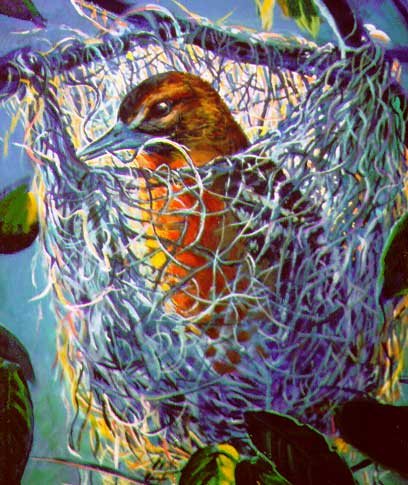
Weaver of Dawn
(Close-up)



|